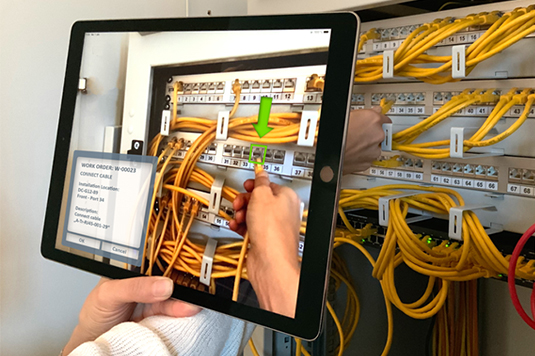Augmented Reality, Virtual Reality and Mixed Reality will play an increasingly important part in society and especially in the working environment of the future. Even though these technologies are far from reaching their zenith and many things are still in the development phase, “Spatial Computing”, i.e. human interaction with a computer that is spatially aware of space and the objects surrounding it, is getting more and more important. Research and development are essential for improving this technology. In our FUTURE.LAB we are facing up to exactly this task in order to enrich and thus improve future working methods in companies by delivering innovative technologies.
How companies can benefit from new technologies
Extending the digital representation of today’s world from the desktop to “Spatial Computing” is a new way of interacting with computers. Smart assistants and fading-in of virtual objects into the user’s field of vision create new exciting applications. In various customer projects described further down in this article, the transfer of training content has been improved and work processes have significantly been optimized.
The training measure at one of our customers included support in learning industrial robot programming using “Augmented Reality”. The AR-glasses in place recognize which robot is involved in a certain scenario. The visualization occurs directly in front of the observer’s eye. When programming the robot there is a great advantage that every movement of the robot can be superimposed via the device, such that both safety zones and the sequential movement of the robot can easily be understood. Furthermore, using AR-Glasses, tool attachments on the robot arm can be displayed holographically without having to attach them to the real object. In addition, the user gets useful hints and tips for the correct operation of the robot.

In the scope of another customer project, the task was to use identical technology to optimize the workflows involved in the maintenance of sprinkler systems. The target group was not specially trained persons who could be given precise instructions on individual work steps via the AR glasses. Thanks to the precise location on the objects, additional information is visualized in front of the observer’s eye. Work orders with individual work steps can thus be created in the system and transmitted to the respective devices (HMDs, smartphones, tablets). The user is then guided through all orders and receives useful hints and warnings during the work processes, which must be observed during the individual steps. In the case of sprinkler systems, for example, valves or pumps can be located faster. Instructions clearly explain what needs to be done at the individual stations. The complete maintenance process can be visualized using this technology, and even the smallest step of the workflow can be supported visually.

Another advantage of “Spatial Computing” lies in guiding external employees or part-time staff who are not familiar with the company’s premises. When dealing with large industrial plants, the technology can be used to get an idea of the situation such that transport paths for larger machines can thoroughly be planned beforehand. External employees already confirm that they believe “having been there before” thanks to the images and instinctively find their way around the site way faster and much better. As a result, the technology supports companies with ‘hot desks’, cross-department teams and new employees in the onboarding process. Especially for industrial plants with complex technical equipment, navigation and quicker orientation play an important part.
The technology also supports decisive workflows in Data Centers, when patching cables into individual ports, for instance. The steps can be projected holographically onto a real rack. When connecting or changing cables to new ports, these are automatically marked and much easier to identify. Consequentially, the user exactly knows which work steps to perform in a specific work order.

The objective of this application in the Data Center area is to significantly reduce error rates when installing and moving assets. Especially when patching or replacing cables, we expect decisive improvements that enable specialist to focus on far more important tasks. Every day work will be made much easier and less error prone. The added value of this particular use case lies in the faster location of devices or ports on one hand, and in the reduction of errors on the other. The quality level will be increased accordingly. This fact will reveal enormous monetary and time saving potentials in the future. The availability of a digital twin of the Data Center will open up totally new fields to display work orders as well as maintenance and malfunction reports.
Future perspectives for the new technology
The individual customer projects clearly illustrate the enormous potential “Spatial Computing” will have for companies. Support for everyday tasks for training purposes or workflows can improve processes, minimize errors and costs and thus increase the overall efficiency of the respective business unit. In addition to increasing the efficiency of maintenance activities, the aspect of seamless, reliable documentation should not be underestimated. The comprehensive digitization of the process means thorough documentation and thus independence from the respective operating personnel. Every employee or external service provider will therefore always be kept on the same level of information and can get an immediate overview of the situation via support of the innovative technology.
If you want learn more about the technologies used or already have your own individual use case in mind, please do get in touch. We are always happy to invite guests for a guided tour of our FUTURE.LAB.